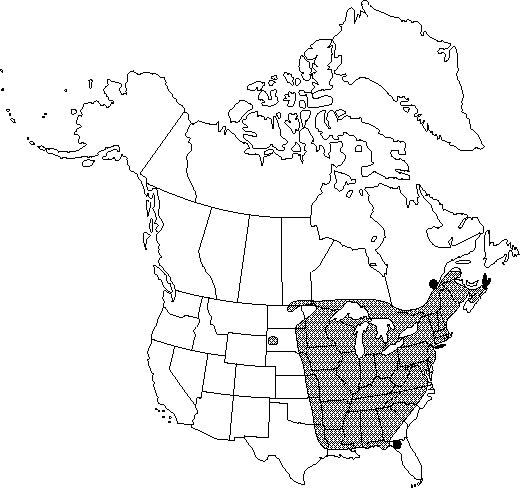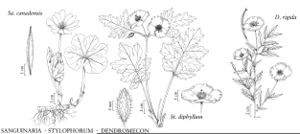Sanguinaria canadensis
Sp. Pl. 1: 505. 1753.
Plants to 4(-6) dm, glabrous; rhizomes branching. Leaves: petiole to 15 cm; blade orbiculate-reniform to cordate-sagittate, mostly palmately 5-7-lobed, to 25 cm wide; margins scalloped; adaxial surface glaucous. Inflorescences: scape to 15 cm. Flowers: sepals ca. 1 cm; petals white or pinkish, oblong to oblanceolate, 15-30 mm; style to 3 mm. Capsules fusiform, 35-60 mm, glabrous. Seeds black to red-orange, obscurely reticulate. 2n = 18 (cult.).
Phenology: Flowering earliest spring.
Habitat: Moist to dry woods and thickets, often on flood plains and shores or near streams on slopes, less frequently in clearings and meadows or on dunes, rarely in disturbed sites
Elevation: 0-1300 m
Distribution

Man., N.B., N.S., Ont., Que., Ala., Ark., Conn., Del., D.C., Fla., Ga., Ill., Ind., Iowa, Kans., Ky., La., Maine, Md., Mass., Mich., Minn., Mo., Nebr., N.H., N.J., N.Y., N.C., N.Dak., Ohio, Okla., Pa., R.I., S.C., S.Dak., Tenn., Tex., Vt., Va., W.Va., Wis.
Discussion
Sanguinaria canadensis has been reported from Mississippi, but no specimens are known.
The leaves of Sanguinaria canadensis are quite variable in shape and size, and the scape and petals vary considerably in length. In some plants the petals are clearly differentiated into sets of two different sizes, but in others the differentiation is barely perceptible. Extremes of variation in these characters have been the bases for recognizing several forms, varieties, and even distinct species, but intermediates of all degrees are found and the variation is only loosely correlated with geography or habitat. Thus, it seems best to limit formal recognition to a single, quite variable species.
Although bloodroot is an ingredient of some compound cough remedies, it contains the poisonous alkaloid sanguinarine, and the U.S. Food and Drug Administration has characterized Sanguinaria canadensis as an unsafe herb (J. A. Duke 1985). Native Americans used it medicinally to treat ulcers and sores, croup, cramps, burns, tapeworms, fevers, diarrhea, and irregular periods, in cough syrups, as a spring emetic and blood purifier, to stop vomiting, and as a love charm, as well as in cermonial face paint (D. E. Moerman 1986).
Selected References
None.
